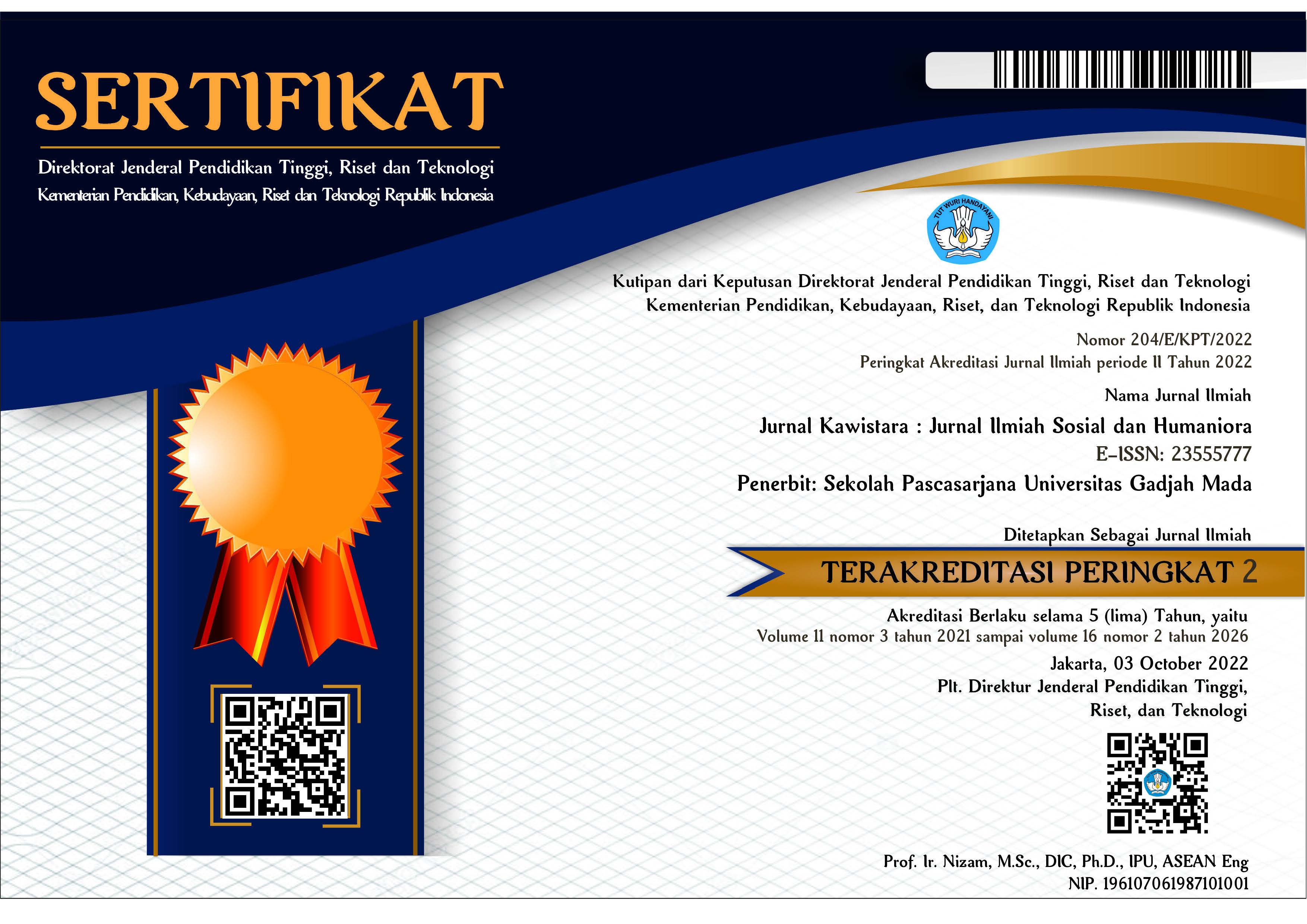"Shirobako":The Representation of Passion and Creative Labor in Japanese Animation Industry
Upik Sarjiati(1*)
(1) Research Center for Area Studies, Indonesian Institute of Sciences (P2W-LIPI)
(*) Corresponding Author
Abstract
Common narratives of the industry include extensive working hours, minimal wages and uncertain conditions. However, there are many creative workers desire to work in anime industry mainly due to passion. The purpose of this research is to analyze the representation of passion and creative labor in Japanese animation industry. Shirobako series provides a case study describing an animated movie production process. Studies on visual and narrative of anime have been conducted; however the study on the production aspect is limited. This study aims to portray anime production complexities and creative labor dynamic. Using constructive approach by Stuart Hall, this study assesses passion on individual and collaborative levels. Based on the results, the passion of creative personnel was personally and subjectively defined. This drive triggers the capacity to acquire new knowledge and endure challenging situations. Furthermore, information sharing and commitment are important qualities of collaborative production. In general, the Shirobako series acknowledged a power relationship gap between production committee members and the creative workforce.
Keywords
Full Text:
PDFReferences
Condry, I. (2013). The Soul of Anime: Collaborative Creativity and Japan’s Media Success Story (1st ed.). Duke University Press.
Creus, A., Clares-Gavilán, J., & Sánchez[1]Navarro, J. (2020). What’s your game? Passion and precariousness in the digital game industry from a gameworker’s perspective. Creative Industries Journal, 13(3), 196–213. https://doi.org/10.1080/17510694.2 019.1685302 .
DePalma, L. J. (2021). The Passion Paradigm: Professional Adherence to and Consequences of the Ideology of “Do What You Love.” Sociological 336 Kawistara, Vol. 11, No. 3, 22 Desember 2021: 329-338 Forum, 36(1), 134–158. https://doi. org/10.1111/socf.12665 .
Duffy, B. E. (2016). The romance of work: Gender and aspirational labour in the digital culture industries. International Journal of Cultural Studies, 19(4), 441–457. https://doi. org/10.1177/1367877915572186
-------. (2017). (Not) getting paid to do what you love: Gender, social media, and aspirational work. In (Not) Getting Paid to do what You Love: Gender, Social Media, and Aspirational Work. Yale University Press. https://doi. org/10.1080/15295036.2018.1433310.
Eiji, O. (2017). An Industry Awaiting Reform: The Social Origins and Economics of Manga and Animation in Postwar Japan. Asia-Pacific Journal-Japan Focus, 15(9).
Fiske, J. (2010). Introduction to Communication Studies. Routledge.
Hall, S. (1997). Representation: Cultural Representation and Signifying Practice. SAGE Publications. Harvey, A., & Shepherd, T. (2017). When passion isn’t enough: gender, affect and credibility in digital games design. International Journal of Cultural Studies, 20(5), 492–508. https://doi. org/10.1177/1367877916636140.
Hesmondhalgh, D., & Baker, S. (2011). Creative Labour: Media Work in Three Cultural Industries. Routledge.
Hill, A. (2015). Spectacle of excess: The passion work of professional wrestlers, fans and anti-fans. European Journal of Cultural Studies, 18(2), 174–189. https://doi. org/10.1177/1367549414563300 Hope, S., & Richards, J. (2015). Loving work: Drawing attention to pleasure and pain in the body of the cultural worker. European Journal of Cultural Studies, 18(2), 117–141. https://doi. org/10.1177/1367549414563299 .
Lewis, D. W. (2018). Shiage and Women’s Flexible Labor in the Japanese Animation Industry. Feminist Media Histories, 4(1), 115–141. https://doi. org/10.1525/fmh.2018.4.1.115.
Long, P., & Barber, S. (2015). Voicing passion: The emotional economy of songwriting. European Journal of Cultural Studies, 18(2), 142–157. https://doi. org/10.1177/1367549414563298.
Loriguillo-López, A., Palao-Errando, J. A., & Marzal-Felici, J. (2020). Making Sense of Complex Narration in Perfect Blue. Animation, 15(1), 77–92. https://doi. org/10.1177/1746847719898784.
McRobbie, A. (2016). Be Creative: Making a Living in the New Culture Industries. Polity Press.
Morisawa, T. (2015). Managing the unmanageable: Emotional labour and creative hierarchy in the Japanese animation industry. Ethnography, 16(2), 262–284. https:// doi.org/10.1177/1466138114547624 .
Napier, S. (2006). “Excuse me, who are you?”: Performance, the gaze, and the female in the works of Kon Satoshi. In B. ST (Ed.), Cinema Anime: Critical Engagements with Japanese Animation (pp. 23–42). Palgrave Mcmillan. https://doi. org/10.1057/9781403983084_2 .
Okeda, D., & Koike, A. (2011). Working conditions of animators: The real face of the Japanese animation industry. Creative Industries Journal, 3(3), 261–271. https://doi.org/10.1386/ cij.3.3.261_1.
Rickards, M. (2006). Screening interiority: Drawing on the animated dreams of Satoshi Kon’s Perfect Blue. Cinephile, 7(1), 1–21.
Schley, M. (2019). Younger Animators Still Struggling Amid Anime Boom. Japan Times. https://www.japantimes. co.jp/culture/2019/05/08/general/ 337 Upik Sarjiati -- “Shirobako”: The Representation of Passion and Creative Labor in Japanese Animation Industry younger-animators-still-struggling[1]amid-anime-boom/ .
Suan, S. (2018). Consuming Production: Anime’s Layers of Transnationality and Dispersal of Agency as Seen in Shirobako and Sakuga-Fan Practices. Arts, 7(3), 27. https://doi. org/10.3390/arts7030027
Stimson, E (2015). Anime Insiders Share How Much Producing a Season Costs. Anime News Network. https:// www.animenewsnetwork.com/ interest/2015-08-13/anime-insiders[1]share-how-much-producing-a[1]season-costs/.91536 .
The Association Japanese Animation (AJA). (2019). Anime Industry Report 2019.
Vallerand, J.R. (2015). The Psychology of Passion: A Dualistic Model (1st ed.). Oxford University Press. Yamamoto, K. (2014). Generalities and Regionality Observed in the Agglomeration Structure of the Animation Industry in East Asia. Springer. https://doi. org/10.1007/978-4-431-55093-8_7.
Article Metrics
Refbacks
- There are currently no refbacks.
Copyright (c) 2021 Upik Sarjiati

This work is licensed under a Creative Commons Attribution-ShareAlike 4.0 International License.
Jurnal Kawistara is published by the Graduate School, Universitas Gadjah Mada.







